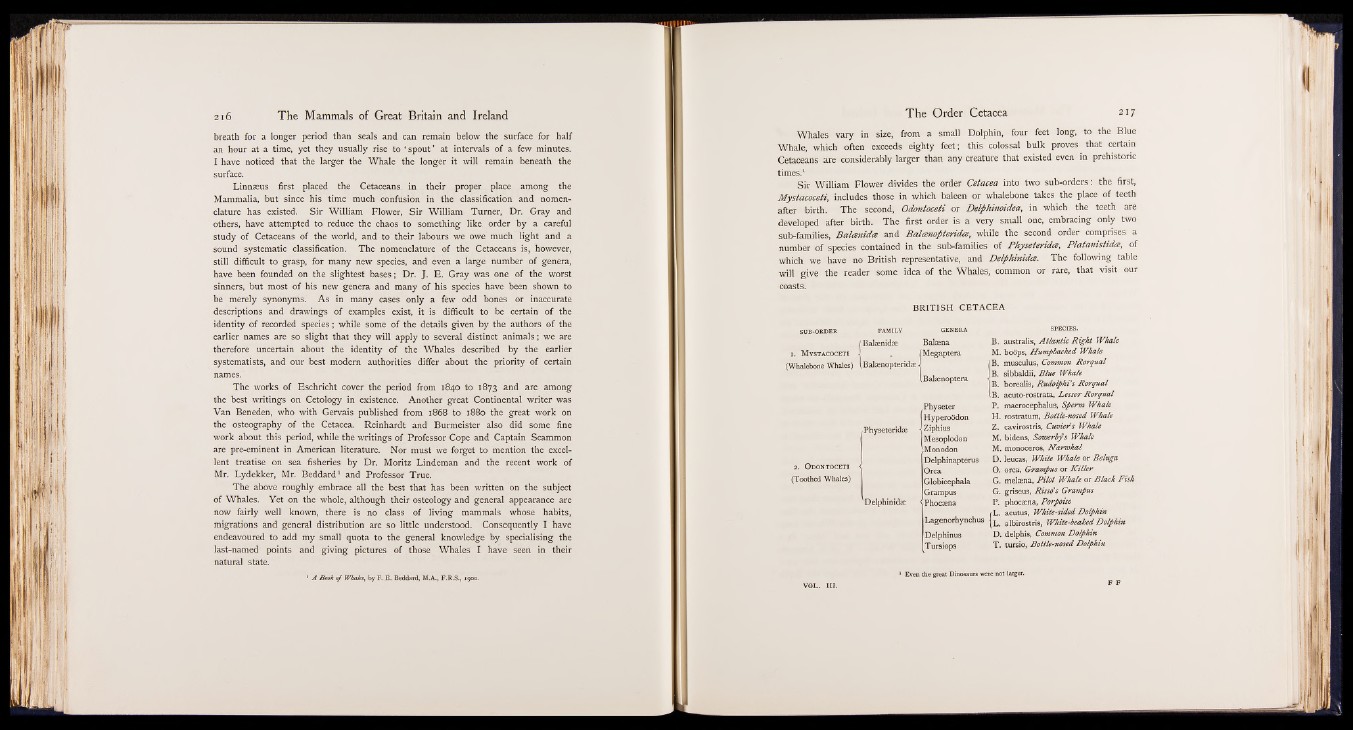
breath for a longer period than seals and can remain below the surface for half
an hour at a time, yet they usually rise to ‘ spout ’ at intervals of a few minutes.
I have noticed that the larger the Whale the longer it will remain beneath the
surface.
Linnaeus first placed the Cetaceans in their proper place among the
Mammalia, but since his time much confusion in the classification and nomenclature
has existed. Sir William Flower, Sir William Turner, Dr. Gray and
others, have attempted to reduce the chaos to something like order by a careful
study of Cetaceans of the world, and to their labours we owe much light and a
sound systematic classification. The nomenclature of the Cetaceans is, however,
still difficult to grasp, for many new species, and even a large number of genera,
have been founded on the slightest bases; Dr. J. E. Gray was one of the worst
sinners, but most of his new genera and many of his species have been shown to
be merely synonyms. As in many cases only a few odd bones or inaccurate
descriptions and drawings of examples exist, it is difficult to be certain of the
identity of recorded species; while some of the details given by the authors of the
earlier names are so slight that they will apply to several distinct animals; we are
therefore uncertain about the identity of the Whales described by the earlier
systematists, and our best modern authorities differ about the priority of certain
names.
The works of Eschricht cover the period from 1840 to 1873 and are among
the best writings on Cetology in existence. Another great Continental writer was
Van Beneden, who with Gervais published from 1868 to 1880 the great work on
the osteography of the Cetacea. Reinhardt and Burmeister also did some fine
work about this period, while the writings of Professor Cope and Captain Scammon
are pre-eminent in American literature. Nor must we forget to mention the excellent
treatise on sea fisheries by Dr. Moritz Lindeman and the recent work of
Mr. Lydekker, Mr. Beddard1 and Professor True.
The above roughly embrace all the best that has been written on the subject
of Whales. Yet on the whole, although their osteology and general appearance are
now fairly well known, there is no class of living mammals whose habits,
migrations and general distribution are so little understood. Consequently I have
endeavoured to add my small quota to the general knowledge by specialising the
last-named points and giving pictures of those Whales I have seen in their
natural state.
1 A Book o f Whales, by F. E. Beddard, M.A., F.R.S., 1900.
Whales vary in size, from a small Dolphin, four feet long, to the Blue
Whale, which often exceeds eighty feet; this colossal bulk proves that certain
Cetaceans are considerably larger than any creature that existed even in prehistoric
times.1
Sir William Flower divides the order Cetacea into two sub-orders; the first,
Mystacoceti, includes' those in which baleen or whalebone takes the place of teeth
after birth. The second, Odontoceti or Delphinoidea, in which the teeth are
developed after birth. The first order is a very small one, embracing only two
sub-families, Balanidce and Balcenopteridce, while the second order comprises a
number of species contained in the sub-families of Physeteridtz, Platanistidee, of
which we have no British representative, and Delphinidcz. The following table
will give the reader some idea of the Whales, common or rare, that visit our
coasts.
B R IT ISH C E T A C E A
SUB-ORDER
1. M ys t a co c et i
(Whalebone Whales)
FAMILY GENERA
' Balaenidae Balaena
. (Megaptera
[Balaenopteridae -
.Balaenoptera
.Physeteridae
2. O d o n to c e t i A
(Toothed Whales)
Delphinidae
Physeter
Hyperoödon
•j Ziphius
Mesoplodon
)Monodon
Delphinapterus
Orca
Globicephala
Grampus
\Phocaena
Lagenorhynchus
Delphinus
Tursiops
species.
B. australis, A tla n tic R ig h t Whale
M. boops, Humpbacked Whale
B. musculus, Common R orqual
B. sibbaldii, B lu e Whale
B. borealis, R u d olp hi's R orqual
B. acuto-rostrata, L esser R orqual
P. macrocephalus, Sperm Whale
H. rostratum, Bottle-nosed Whale
Z. cavirostris, C uvier's Whale
M. bidens, Sowerby's Whale
M. monoceros, N a rw hal
D . leucas, W hite W hale or Beluga
O. orca, Grampus or K ille r
G. mekena, P ilo t W hale or B la ck F ish
G. griseus, R isso’s Grampus
P. phocaena, Porpoise
(L . acutus, W hite-sided D olphin
{ l . albirostris, White-beaked D olphin
D. delphis, Common D olphin
T . tursio, Bottle-nosed D olphin
VO L. III.
1 Even the great Dinosaurs were not larger.
F F